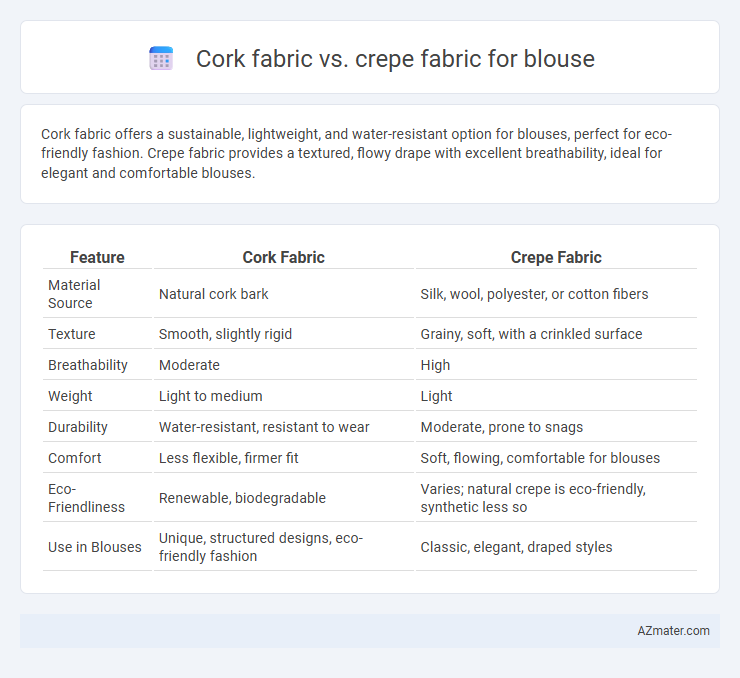Cork fabric offers a sustainable, lightweight, and water-resistant option for blouses, perfect for eco-friendly fashion. Crepe fabric provides a textured, flowy drape with excellent breathability, ideal for elegant and comfortable blouses.
Table of Comparison
| Feature | Cork Fabric | Crepe Fabric |
|---|---|---|
| Material Source | Natural cork bark | Silk, wool, polyester, or cotton fibers |
| Texture | Smooth, slightly rigid | Grainy, soft, with a crinkled surface |
| Breathability | Moderate | High |
| Weight | Light to medium | Light |
| Durability | Water-resistant, resistant to wear | Moderate, prone to snags |
| Comfort | Less flexible, firmer fit | Soft, flowing, comfortable for blouses |
| Eco-Friendliness | Renewable, biodegradable | Varies; natural crepe is eco-friendly, synthetic less so |
| Use in Blouses | Unique, structured designs, eco-friendly fashion | Classic, elegant, draped styles |
Introduction to Cork and Crepe Fabrics
Cork fabric, derived from the outer bark of the cork oak tree, offers a sustainable, water-resistant, and lightweight option perfect for unique blouse designs. Crepe fabric, made from various fibers like silk, wool, or synthetic materials, is known for its crinkled texture, excellent drape, and breathable quality, enhancing silhouette and comfort. Both fabrics provide distinctive aesthetics and tactile experiences, catering to different fashion preferences and functional needs in blouse construction.
Origins and Production Methods
Cork fabric originates from the bark of the cork oak tree primarily found in Mediterranean regions, where strips of bark are harvested sustainably without harming the tree, then processed and bonded with fabric backing to create a lightweight, durable textile ideal for blouses. Crepe fabric traces back to ancient Persia and has evolved through various cultures, produced by weaving silk, wool, or synthetic fibers with a distinctive twisted yarn technique or by applying chemical treatments to create its characteristic crinkled texture. The production of cork fabric involves natural, eco-friendly methods emphasizing regeneration, while crepe fabric relies on intricate weaving or finishing processes that influence its drape and texture.
Texture and Appearance Comparison
Cork fabric features a smooth, leather-like texture with a matte finish, offering a natural, eco-friendly appearance ideal for structured blouses. Crepe fabric provides a slightly crinkled, grainy texture with a soft drape, lending a fluid and elegant look perfect for flowing blouse designs. The contrasting textures influence the blouse's overall aesthetic, with cork delivering a modern, minimalist vibe and crepe emphasizing sophistication and movement.
Sustainability and Eco-friendliness
Cork fabric, made from renewable cork oak bark, offers superior sustainability due to its biodegradability and minimal environmental impact during harvesting. Crepe fabric, typically derived from synthetic fibers or silk, often involves water-intensive processes and chemical treatments that reduce its eco-friendliness. Choosing cork fabric for blouses significantly lowers the carbon footprint while supporting eco-conscious fashion initiatives.
Comfort and Breathability for Blouses
Cork fabric offers moderate breathability and is often chosen for its eco-friendly properties rather than comfort in blouses. Crepe fabric, with its lightweight, slightly crinkled texture, provides superior breathability and comfort, making it ideal for warm weather wear. The natural fibers in crepe enhance airflow and moisture absorption, ensuring a cooler, more comfortable blouse compared to cork fabric.
Durability and Maintenance Requirements
Cork fabric, made from natural cork bark, offers exceptional durability due to its resistance to abrasion, water, and stains, making it ideal for long-lasting blouses with minimal wear. In contrast, crepe fabric, typically woven from silk, wool, or synthetic fibers, requires more delicate care to maintain its texture and is prone to wrinkling and pilling, increasing maintenance demands. Cork fabric's easy-to-clean surface and robustness contrast sharply with crepe's need for gentle handling and specialized cleaning methods.
Versatility in Fashion Design
Cork fabric offers exceptional durability and eco-friendly appeal, making it a unique choice for fashion designers aiming to create sustainable blouses with a textured, natural aesthetic. Crepe fabric excels in versatility with its lightweight, drapey quality and diverse fiber content, allowing for elegant, flowing blouse designs suitable for both casual and formal wear. Designers favor crepe for its wide range of colors and finishes, while cork fabric is preferred for innovative, statement pieces that emphasize structure and environmental consciousness.
Cost and Accessibility
Cork fabric is typically more expensive and less accessible than crepe fabric due to its unique production process and limited sourcing, making it a premium choice for blouses. Crepe fabric is widely available in various price ranges and is more cost-effective, offering greater accessibility for everyday blouse designs. The affordability and availability of crepe fabric make it a popular option for budget-conscious consumers and mass production.
Popular Brands and Market Trends
Cork fabric, known for its eco-friendly and sustainable properties, is increasingly favored by popular brands like Stella McCartney and Patagonia for blouse designs that emphasize natural textures and lightweight durability. Crepe fabric remains a market staple among luxury brands such as Gucci and Prada, offering a smooth, wrinkle-resistant finish ideal for elegant, flowing blouses in both casual and formal wear. Current market trends show a growing demand for cork fabric in sustainable fashion collections, while crepe retains strong popularity due to its versatility and classic appeal.
Choosing the Right Fabric for Your Blouse
Cork fabric offers a unique, eco-friendly option with a smooth, leather-like texture and excellent durability for blouses, ideal for structured, statement designs. Crepe fabric provides a lightweight, flowy feel with natural elasticity, perfect for blouses requiring drape and softness. Selecting between cork and crepe depends on the desired blouse style--opt for cork for a bold, textured look and crepe for elegance and comfort.

Infographic: Cork fabric vs Crepe fabric for Blouse
 azmater.com
azmater.com